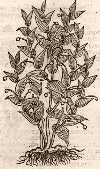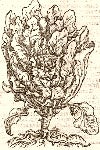

 |
 |
Cruydeboeck. English
A Niewe Herball, or, Historie of Plantes: Wherein is Contayned the Whole Discourse and Perfect Description of All Sortes of Herbes and Plantes, Their Divers & Sundry Kindes. . .and That Not Onely of Those Whiche are Here Growyng in This Our Countrie of Englande, but of All Others Also of Forrayne Realmes Commonly Used in Physicke.
First set foorth in Doutche or Almaigne tongue by that learned D. Rembert Dodoens . . .and nowe first translated out of French into English, by Henry Lyte. London: By Gerard Dewes, 1578. Translation based on L'Ecluses French translation--Cf. Hunt 132. First edition, second issue---Cf. Johnston, S. H. Cleveland coll. 118. Colophon: Imprinted at Antwerpe by me Henry Loe bookeprinter, and are to be solde at London in Powells Churchyards, by Gerard Dewes. Title within illustrated border; woodcuts throughout. References: Hunt 132; Johnston, S. H. Cleveland coll. 118; STC 6984.
Henry Lyte translated into English this originally Dutch work by Dodoens titled Cruydeboeck. In this Dodoens did not follow the alphabetical arrangement of past authors, but instead, took a step forward by grouping the plants according to their characteristics. Dodoens, Clusius, and de L'Obel worked so closely together that it is difficult to tell exactly who wrote what. They corresponded frequently, sharing their findings, and they even shared illustrations of their works with each other. Dodoens' first major work was Cruydeboeck, but after repeated usage the blocks began to show signs of wear. Some of the blocks are still preserved in the Museum Plantin-Moretus in Antwerp, Belgium. Dodoens is best known to English readers through translations of his work by Henry Lyte, who deserves much credit for his accuracy. Unlike most translators, Lyte was an amateur botanist who understood the material he was translating. He is credited with making significant corrections to the original text and accurately incorporating new material sent him by Dodoens during the course of his work. It is possible that Shakespeare consulted the Niewe Herball for information regarding plant lore found in his plays. Edmund Spencer's references to flowers in his Shepheardes Calendar may have been inspired by his seeing this herbal where Lyte describes, among others, the "gillofers and pinkes."
Subjects: : Botany--Pre-Linnean works.
PAT-113